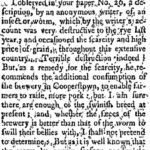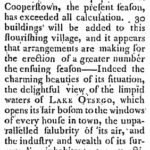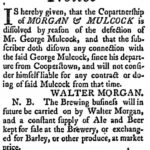 Standing in the mid-1790s looking forward in time, I have a sense of things changing in the history of New York brewing. I am a bit concerned that in a few years I will be facing a confusing mass of information coming at me too soon, from too many directions. Still, for now as the frontier just begins to fill there are stories which are manageable. We certainly understand the situation in Albany and in New York City itself at 1790 where long standing families still controlled the market as they have for generations. Soon these dynasties will be outnumbered as new immigrants arrive, some close up sensing change. Others struggle with the coming grim reality. As the frontier lands begin to be populated and repopulated in the first decade after the American Revolution new breweries open in new towns. We have seen breweries opening to the northeast of Albany in Galway and Stillwater in the 1790s. There is one more in Kingston advertising in January 1795 and another posting a notice in Troy the next month. We have seen how beer shows up in the last years of the decade in western New York related to the colonization coming up from Baltimore along the Susquehanna which flows to the south. And in 1795, a brewery opened in Cooperstown.
Standing in the mid-1790s looking forward in time, I have a sense of things changing in the history of New York brewing. I am a bit concerned that in a few years I will be facing a confusing mass of information coming at me too soon, from too many directions. Still, for now as the frontier just begins to fill there are stories which are manageable. We certainly understand the situation in Albany and in New York City itself at 1790 where long standing families still controlled the market as they have for generations. Soon these dynasties will be outnumbered as new immigrants arrive, some close up sensing change. Others struggle with the coming grim reality. As the frontier lands begin to be populated and repopulated in the first decade after the American Revolution new breweries open in new towns. We have seen breweries opening to the northeast of Albany in Galway and Stillwater in the 1790s. There is one more in Kingston advertising in January 1795 and another posting a notice in Troy the next month. We have seen how beer shows up in the last years of the decade in western New York related to the colonization coming up from Baltimore along the Susquehanna which flows to the south. And in 1795, a brewery opened in Cooperstown.
Historian Alan Taylor won the Pulitzer Prize for his book William Cooper’s Town in 1996. Like the colonization of the Conhocton via the Susquehanna centered on a new town, Bath, the creation of Cooperstown was an example of one land owner developing a district and a community as a personal investment. Unlike at Bath, Cooper did not depend solely on his agent and was personally involved. And that, as Taylor explains, included building a brewery:
An even more significant proof of Cooperstown’s advancing civilization was that beer, as well as water, flowed in the village by early 1796. As in the maple sugar production, William Copper encouraged a brewery as an act of both social benevolence and economic service. During the 1790s many enlightened gentlemen promoted the drinking of beer and ale as antidotes to Americans’ swelling consumption of the more ardent distilled liquors associated with alcoholism, poverty, and violence. In New York City Cooper met and recruited Walter Morgan and George Mulcock, English immigrants and brewers who removed to Cooperstown in the spring of 1795. Extolling the projected brewery as a patriotic and philosophic manufactory,” Phinney’s newspaper asked and exhorted the locals: “What shall we do? Drink beer, till we are merry.”
The enterprise takes off with great hope. Up top, the notice in the 18 September 1795 edition of the Otsego Herald in which the brewers offer the highest price in cash for any quantity of barley. They hope to brew so much that farmers of the district not have to export it out of the county. The clipping to the left looks like a letter to the editor. It’s from the paper’s 9 October edition and seems to oppose the development, the drinking and being merry line being sarcastic. The notice in the middle from October 30th describes a fairly significant operation. The brewery 83 by 25 feet with a 19 foot high roof line. Taylor states that Cooper invested over £270 in the construction. He was also building a library, a school and a lodge for the Freemasons. The brewery caught fire in December 1796 but was saved when “the villagers rushed out to subdue the flames.”
It did not last as first envisaged. By April 1797, George splits town and partner, Walter, dissolves the partnership based on the defection as you can see from the notice at the right up there. It probably was not entirely Walter’s fault. In 1795 the district had a booming grain growing economy feeding into the European market ravaged by the Napoleonic wars. By 1797, the Hessian fly was ravaging crops here as it was elsewhere. And there was the Panic of 1796-97. Plus, as Taylor explains, by the summer of 1796 Cooper as Federalist patriarch is facing a younger generation of more republican men of merit who defeated Cooper in his bid for a seat in Congress. It split the community. Perhaps George Mulcock picked the wrong side. Plus a local wave of anti-Masonry bigotry broke out, too, in response to the new lodge. Maybe he was a Mason.
William Morgan appears to have met a bit of a weird end. In 1827, the Governor of New York wrote the Lieutenant Governor of Upper Canada to state that Morgan had been kidnapped and taken across the international border. A reward was offered of $200 just to for information on his whereabouts. If that in fact is the same Morgan, the man of fifty stories and rabid anti-Mason.



